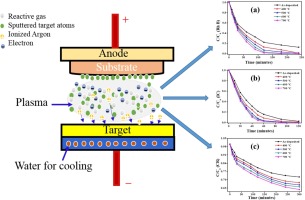当前位置:
X-MOL 学术
›
Solid State Sci.
›
论文详情
Our official English website, www.x-mol.net, welcomes your
feedback! (Note: you will need to create a separate account there.)
Reactive magnetron sputtering based synthesis of WO3 nanoparticles and their use for the photocatalytic degradation of dyes
Solid State Sciences ( IF 3.4 ) Pub Date : 2020-01-01 , DOI: 10.1016/j.solidstatesciences.2019.02.008 Monu Verma , Krishna Pal Singh , Ashwani Kumar
Solid State Sciences ( IF 3.4 ) Pub Date : 2020-01-01 , DOI: 10.1016/j.solidstatesciences.2019.02.008 Monu Verma , Krishna Pal Singh , Ashwani Kumar

|
Abstract Current study explores the synthesis of WO3 nanoparticles using highly effective novel physical vapour deposition process, reactive magnetron sputtering technique followed by annealing at different temperatures. The characterization of the synthesized samples were carried out by powder XRD, Raman spectroscopy, FE-SEM, TEM, BET, and diffuse reflectance spectroscopy (DRS) to check the crystallinity, morphology, surface area, and optical properties, respectively. Results display that the crystallinity and the crystallite size increases after heating the samples continuously. The morphology was found to be spherical type with high aggregation at low temperature. As-deposited nanoparticles display the highest surface area 66.78 m2/g and it decreases up to 20.45 m2/g with increasing the particle size up to 48 nm. The photocatalytic activity of the WO3 nanoparticles was evaluated in the degradation reactions of rhodamine B (Rh B), indigo carmine (IC), and Congo red (CR) in aqueous solution under UV–vis radiation. The highest photocatalytic activity was observed with highly crystalline WO3 nanoparticles and the order of the different organic dyes degradations was: IC > Rh B > CR. The degree of mineralization of organic dyes by WO3 nanoparticles was determined by total organic carbon (TOC) analysis and reaching percentages of mineralization of 76% Rh B, 87% for IC, and 8% for CR for 96 h of lamp irradiation. A proposed mechanism for the photocatalytic activity of synthesized WO3 was investigated in the presence of different scavengers which suggested that mechanism occurs through hydroxyl radicals rather than holes and peroxide radicals.
中文翻译:

基于反应磁控溅射的 WO3 纳米粒子的合成及其在光催化降解染料中的应用
摘要 当前的研究探索了使用高效的新型物理气相沉积工艺、反应磁控溅射技术以及随后在不同温度下退火的 WO3 纳米颗粒的合成。通过粉末 XRD、拉曼光谱、FE-SEM、TEM、BET 和漫反射光谱 (DRS) 对合成样品进行表征,分别检查结晶度、形貌、表面积和光学性质。结果表明,连续加热样品后结晶度和晶粒尺寸增加。发现形态为球形,在低温下具有高聚集性。沉积态纳米粒子的最高表面积为 66.78 m2/g,随着粒径增加至 48 nm,表面积下降至 20.45 m2/g。WO3 纳米粒子的光催化活性在紫外-可见光辐射下在水溶液中的罗丹明 B (Rh B)、靛蓝胭脂红 (IC) 和刚果红 (CR) 的降解反应中进行评估。观察到高度结晶的 WO3 纳米颗粒具有最高的光催化活性,不同有机染料降解的顺序是:IC > Rh B > CR。WO3 纳米粒子对有机染料的矿化程度由总有机碳 (TOC) 分析确定,并在灯照射 96 小时内达到 76% Rh B、87% IC 和 8% CR 矿化百分比。在不同清除剂的存在下研究了合成 WO3 光催化活性的拟议机制,这表明该机制是通过羟基自由基而不是空穴和过氧化物自由基发生的。
更新日期:2020-01-01
中文翻译:

基于反应磁控溅射的 WO3 纳米粒子的合成及其在光催化降解染料中的应用
摘要 当前的研究探索了使用高效的新型物理气相沉积工艺、反应磁控溅射技术以及随后在不同温度下退火的 WO3 纳米颗粒的合成。通过粉末 XRD、拉曼光谱、FE-SEM、TEM、BET 和漫反射光谱 (DRS) 对合成样品进行表征,分别检查结晶度、形貌、表面积和光学性质。结果表明,连续加热样品后结晶度和晶粒尺寸增加。发现形态为球形,在低温下具有高聚集性。沉积态纳米粒子的最高表面积为 66.78 m2/g,随着粒径增加至 48 nm,表面积下降至 20.45 m2/g。WO3 纳米粒子的光催化活性在紫外-可见光辐射下在水溶液中的罗丹明 B (Rh B)、靛蓝胭脂红 (IC) 和刚果红 (CR) 的降解反应中进行评估。观察到高度结晶的 WO3 纳米颗粒具有最高的光催化活性,不同有机染料降解的顺序是:IC > Rh B > CR。WO3 纳米粒子对有机染料的矿化程度由总有机碳 (TOC) 分析确定,并在灯照射 96 小时内达到 76% Rh B、87% IC 和 8% CR 矿化百分比。在不同清除剂的存在下研究了合成 WO3 光催化活性的拟议机制,这表明该机制是通过羟基自由基而不是空穴和过氧化物自由基发生的。










































 京公网安备 11010802027423号
京公网安备 11010802027423号